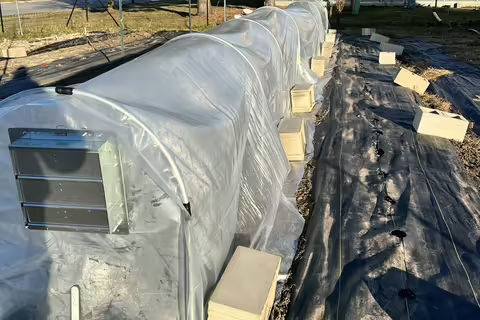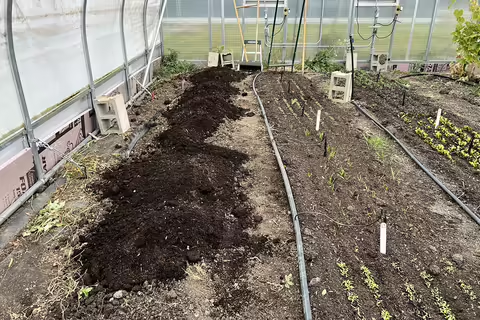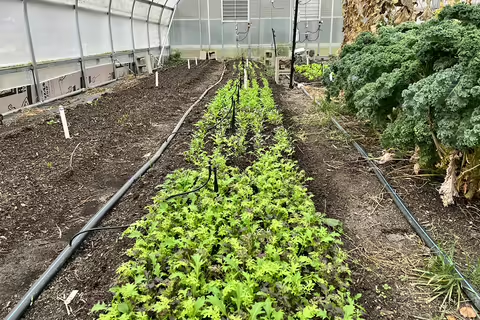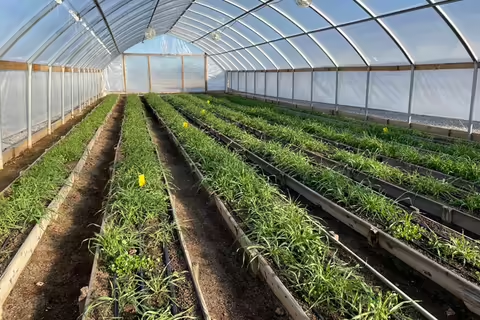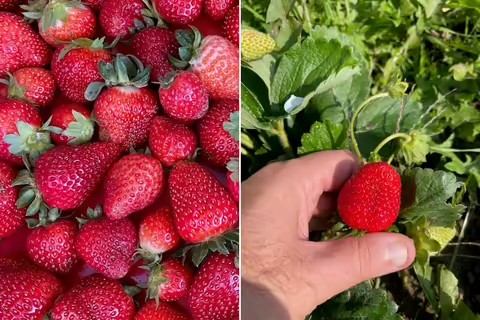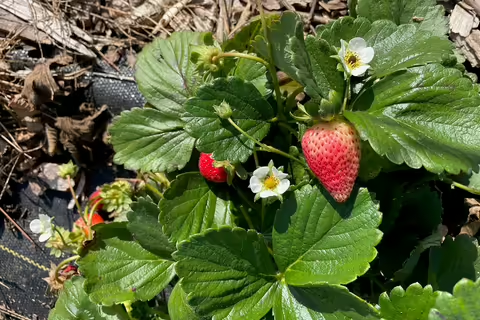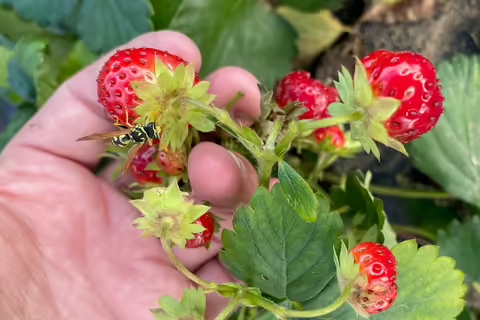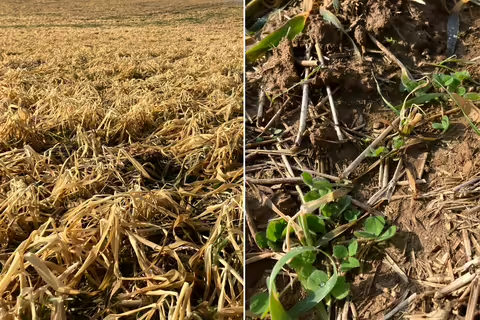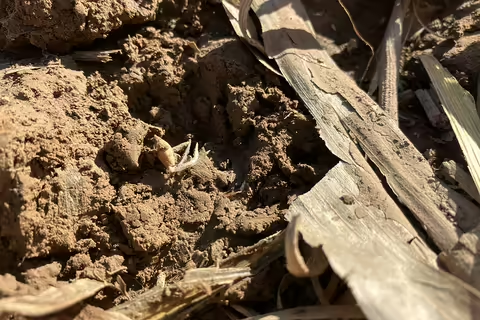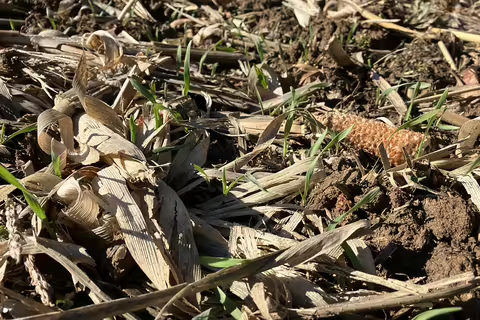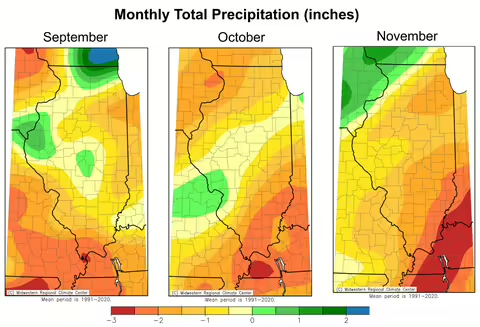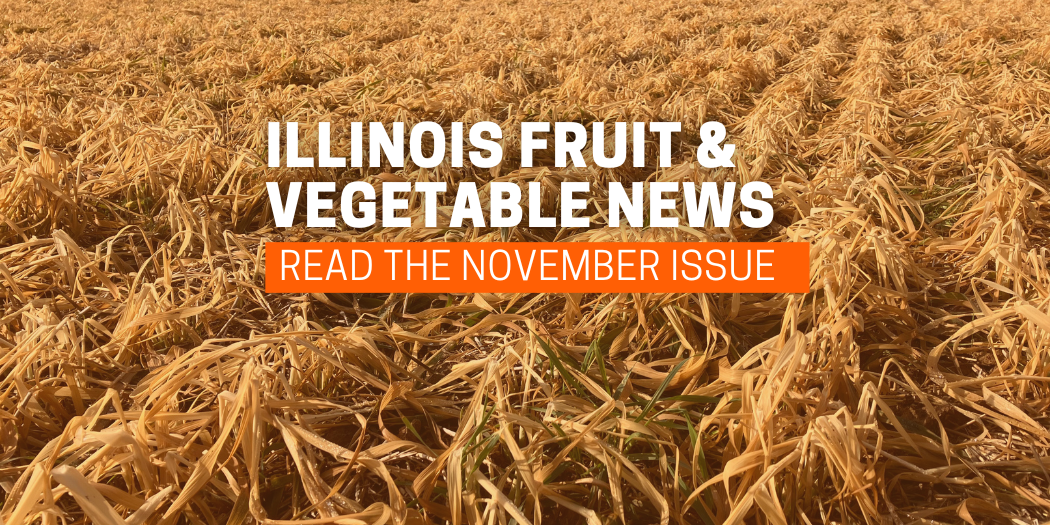
Northern Illinois Stateline Fruit and Vegetable Growers Conference
Save the date! We are pleased to announce the return of the Stateline Fruit and Vegetables Growers Conference in Rockford, Illinois on Monday, February 6 at NIU Rockford. This year’s program will include a keynote from Dr. Emily Lavely of Michigan State University. Currently a fruit tree educator in western Michigan, she’ll be providing the keynote “Exploring the world of roots in perennial Production Systems.” She’ll join us later that day in our fruit track for "Pruning to Match your System: Considerations for Rootstock and Tree Vigor.”
Additional topics for the breakouts will include high tunnel vegetable research, day-neutral strawberries, and mechanical weed management. Mohammad Babadoost and Kacie Athey will be providing their yearly grower and research updates for the fruit-vegetable tracks. For our breakouts, we’ll be joined by Zack Grant, local foods and small farms educator for Cook County, and Sam Oschwald-Tilton, vegetable educator for UW-Madison.
More details and registration will be provided in the weeks to come. Please send Grant McCarty (gmccarty@illinois.edu) an email if you’d like to be added to the list to be notified when registration is open.
South Suburban Cook Urban Agriculture Demonstration and Research Report
The outdoor season at SoSuCo has been effectively over for the past few weeks, with the sub-20-degree temperatures experienced during the first weeks of November. However, we have overwintered one bed of fall-planted spinach and carrots. This planting has reached near the harvestable stage and is protected by a plastic-covered low tunnel. This demonstration aims to see if freeze-hardy crops will successfully overwinter with a minimalist structure. Hopefully, we will see survival and vigorous growth in late February through early spring resulting in an extra early crop of carrots and spinach.
The transition from warm season fruiting vegetables to winter crops is complete in the high tunnel. One ongoing challenge with the transition is bed preparation between crops. My previous experience with high tunnel production has been with movable tunnels, which allow for easier bed preparation and planting of an uncovered space before moving the tunnel over the prepared site for winter protection. In static high tunnel production, crop transitions and bed prep take place all under cover. The physical logistics of this can be challenging, but the most significant consideration I have overlooked is soil moisture levels.
High tunnels on timed drip irrigation all summer tend to have wet soils when it comes time to pull a tomato crop out to transition to winter greens. This wet soil condition, coupled with our somewhat poorly drained soil, makes it almost impossible to work the bed. Instead, we have been applying 3-4 inches of low-N leaf compost on a roughly broadforked bed. This creates enough profile to plant into and grow winter greens to maturity.
Even though we use a tensiometer to manage moisture levels with the timed drip irrigation system, the static tunnel beds tend to stay wetter than those exposed to dry weather windows outdoors. A long-term solution might be to adopt structured raised beds (like those at Dixon Springs) or install drain tile to remedy the somewhat poorly drained conditions of the high tunnel native soil beds.
One final note from the high tunnel relates to having consistent access to frost-free water for transitioning to winter crops. The picture shows one bed on the right that successfully germinated and established when our automated microsprinkler irrigation system was still in operation.
The bed on the left utilized inconsistent hand watering from our water tank after we winterized our seasonal water source due to an early freeze in October. The bed was planted to spinach, which can be challenging to germinate during the shoulder season, but the lack of consistent microsprinkler irrigation resulted in poor germination and stand establishment. Having consistent automated overhead irrigation for establishing winter crops is essential.
Be sure to stay connected to the Urban Ag Connect vlog series for other updates related to SoSuCo. Enjoy the holiday season and winter growing!
Zack Grant (708-679-6889; zgrant2@illinois.edu)
St. Louis Metro East Regional Report
So far November has broken the dry cycle in the St Louis Metro East. The first significant snow fall came early morning on Nov. 12, which for those in the northern reaches was just a dusting while others to the south needed snowplows. The Freeburg area (St Clair County) reported the heaviest snowfall with upwards of 7.5 inches blanketing the area. Most of the area received at least one-half inch and upwards of an inch in the northern areas over Thanksgiving and the following weekend. Temperatures are working their way into winter, with the coldest night/morning so far of 17° reported on Nov. 20. Soil temps are still well above freezing, allowing for ongoing horseradish harvest.
As a reminder to Illinois cider producers, the From Food to Flowers: Everything Local Conference (previously the Illinois Specialty Crops Conference) will be hosting the annual Illinois State cider contest again this year. If you intend to enter the contest, make sure to reserve some of your product now by freezing. The 2023 From Food to Flowers: Everything Local is being held at the Crown Plaza Hotel in Springfield Jan. 11 - 13. The cider contest will be held Thursday, Jan. 12, and awards will be presented at the evening banquet that same day. Cider contest details are now available, and for additional questions, contact ISHS Cider Contest coordinator Ken Johnson at 217-243-7424 or kjohnso@illinois.edu.
Elizabeth Wahle (618-344-4230; wahle@illinois.edu)
Southwestern Illinois at Waterloo Regional Report
The last month has been quite a ride for the weather conditions for late fall. Early in the month, we maintained warmer than normal conditions. As usual, we caught a cold front to drop the bottom out of the temperatures, bringing us closer to more winter-like conditions. Nov. 10 we were pushing 80°F for a high temperature; two days later, on Nov. 12, we woke up to 6 to 7 inches of snow! The snow surprised just about everyone as the forecast the night before called “for maybe a few flurries or a dusting.” Monroe County was part of a narrow band of moisture that passed through the area with this front. It was cold enough that the snow stayed around until around mid-day on the 13th. It was warm enough that roads were fairly easy to clear. This was followed up with some more light snow the next week; however, accumulations were minimal from this system.
Since then, we have had more seasonal temperatures with highs mainly in the 40s with some days a little above or below that. We have had a few cold nights with lows dipping down to the upper teens in the morning. The moisture from the snow and a few rain systems has been welcomed to help replenish soil moisture. The soil is fairly wet on the surface but those that have done excavation have said it is still dry deeper in the soil profile from the extended dry and drought conditions earlier in the fall.
There is not a lot going on out in the fields. With row cover, fall crops like greens and cole crops are still in harvest. Many of those crops are behind or struggled greatly from the dry earlier in the season, and once we finally had the moisture, the temperatures were lower, slowing the growth rate.
Pumpkin season wrapped up fairly well with good sales, but also many still having a good supply of pumpkins at the end of the season. You hate to see them go to waste but remember, if left in the field those nutrients and organic matter return to the soil again for the next season’s crop.
Also, I have found more and more interest from livestock producers in feeding pumpkins to sheep, goats, chickens, etc. Pumpkins are very nutritious, although pound for pound contain a lot of water compared with hay and other feeds. This can be a positive this time of year when fresh, lush green grass is not available. While the market price for this avenue is a fraction of the retail jack-o-lantern market, it can be a good way to help clean up prepicked leftovers and help them find a good home.
On our family farm, we have now shifted gears to making wreaths for the Christmas season and contemplating opportunities, improvements, and changes we want to make for 2023. Here’s to a great rest of 2022, and we will talk to you all in 2023!
Nathan Johanning (618-939-3434; njohann@illinois.edu)
Dixon Springs Ag Center Regional Report
Like other parts of the state, November was a temperature roller coaster at our location, with the ten days or so being unseasonably warm and then the rude awakening of winter hit with both cold and snow. Snow accumulation ranged from 1.5-3” and was gone by Nov. 13.The rest of the month has felt pretty normal and we have received a couple of rain showers to help add moisture back into our dry soils.
We have winterized the hydroponic tunnel, removing all of the sylenoids and fertilizer injectors and letting the main irrigation header lines drain. The one portion of the hydroponic tunnel that is still up and running is our NFT lettuce table. With the continuous circulation of nutrient solution, this system can stay operational longer into the winter season, but with no external heat source in the tunnel, it won’t be sustainable during long periods of below freezing temperatures. Plant material and perlite from the rest of the tunnel has been removed and we will begin the sanitation process over the next few weeks. Winterization is also complete for our outdoor wash station area and on several pieces of equipment, including tillers, sprayers, weedeaters, mowers, and the steam sterilizer.
The spring oat and crimson clover cover crop that was seeded on Oct. 3 has established well and is filling in the beds nicely. We used overhead hand watering to make sure even and adequate moisture was provided and then switched to three lines of drip irrigation per bed. We are watering through the drip line maybe once per week but really nothing more is needed at this time. The side curtains have been left open about 8 inches in order to help moderate the high tunnel temperature, allowing for cooler outside air to circulate and keep plant growth at a slower rate.
Only a few spring oat plants in about 4 foot of row in an outside bed have succumbed to winter kill. Yellow sticky traps have been placed throughout the tunnel to aid in insect monitoring and in mid December, pitfall traps will also be added to the beds. Just as a reminder, this tunnel and the other in ground, raised bed tunnel are being used in a research project, “Strategies for Improving Biological Control of Insect Pests for Vegetable Growers Utilizing High Tunnels,” funded through the Illinois H.R. 133 Stimulus Grant Program. The other tunnel serves as a control and no cover crops or cut flowers will be planted in it.
Photo: Spring oat and crimson clover cover crops growing in one of the high tunnels at DSAC by B. Aly.
Bronwyn Aly (618-695-2441; baly@illinois.edu)
Northern Illinois Day-Neutral Strawberry Research
We wrapped up the first year of our day-neutral strawberry research in Northern Illinois in mid-October. As mentioned previously, this is a 2 year study of 3 varieties (‘Albion’, ‘Seascape’, and ‘Mara Des Bois’) of annual strawberries to determine their suitability for growing at two different locations with different grower needs: a mixed vegetable operation and a U-Pick strawberry operation and apple orchard. A typical season for day-neutral strawberries involves planting as bare roots in May and removing at the end of October, eliminating overwintering.
Strawberries from all 3 varieties are represented from our orchard site harvest from Oct. 18. This was our last harvest from this site for the season. Peak yields began in mid-September at the orchard site.
At our U-pick/apple orchard site, strawberry harvest and yield data collection began the end of August with peak of yields and quality towards the end of September. We continued harvesting from this site until mid-October. Due to an impending freeze and noticeable declines in fruit quality/expected future yields, the season ended early as we hoped to continue harvesting till Halloween. This site was without irrigation.
Our mixed vegetable operation began harvest the end of July, under drip irrigation and plasticulture. Peak was near Labor Day for this crop and continued to yield to mid-October like our other site. One management issue that we encountered this season was severe insect pest pressure. Lygus bugs, yellowjackets, grasshoppers, and other insects were noticeable and had to be controlled to ensure better quality. We also encountered small mammal damage throughout the season.
Strawberries were still flowering towards the end of September at both sites. Typically, it’s 4 to 6 weeks from flower to fruit so most of these flowers would not produce fruit in time before our first freeze.
Lygus bug damage was noticeable in the misshapen fruit. During this period, we further encountered other insect pests like yellowjackets.
Anecdotally, we were pleased with the size and flavor of the berries. Peak yields and continually yields seem to further align with the needs of these two growers. However, we still need another year to make accurate evaluations to form recommendations of varieties and practices. In addition, an economic analysis will be performed factoring in labor and other costs.
In September, I spoke with the Good Growing team about this project. You can view it as a video on YouTube or as a podcast. I’ll also be discussing it at many of our winter meetings.
Grant McCarty (815-235-4125; gmccarty@illinois.edu)
Cover Crop Update
Fall cover crops have had a challenging season in southern Illinois. Many lacked rainfall to achieve optimal growth in the fall and the stand was variable based on moisture. Once moisture was available some abruptly colder conditions followed.
On our farm, we had a spring oat/crimson clover cover planted in early September. The oats were very slow to establish due to the dry but did get modest growth eventually. Despite some of the snow earlier in the month, as of mid to late November it finally did get cold enough to terminate the crop. Typically, spring oats can handle down to the low 20s and we had a few nights down to the upper teens.
The crimson clover struggled much more. Stand establishment was much less given the dry and much of it sat for over a month until it received the needed moisture before it finally germinated. The growth here is reduced from typical years given the planting date; however, it hopefully should be established well enough to survive the winter. Remember, cover crops do not have to appear as a solid stand to have a benefit.
One of those benefits that is hard to see is the root growth of our cover crops. Remember that the roots are the first part of the plant to grow. Also, the soil resists temperature changes so even on some cold days the roots will have more mild temperatures in the soil to support growth.
Notice on the germinating winter barley seed a week after planting there are multiple roots already as large as the seed and there is no leaf even present yet. It is easy to see a small cover crop going into winter and undervalue what it is contributing. Root growth is a major value to our cover crops.
We also broadcast some cereal rye (60 lb/A) over a freshly harvested corn field just a few days before the snow 11/12. The snowfall was about as ideal as you could ask for a surface seeded crop. Providing constant moisture and helping to move the seed right to the soil surface you can now see just in 3 weeks we have a nice stand of rye coming in.
Late in the season, cereal rye is still the best cover crop option due to its cold tolerance and its ability to germinate with soil temperatures down to 34°F. Cereal rye is the most cold hardy of our winter grains.
Hopefully, these updates give a little perspective and insight into cover crops as we head into the winter season.
Top Photos: A spring oat cover crop terminated by temperatures in the teens (left). Crimson clover off to a slow start after excessive dry after planting (right). Photos: N. Johanning
Middle Photo: Germinating winter barley seed. Photo: N. Johanning
Bottom Photo: Broadcast cereal rye growth 3 weeks after a November 10 planting date. Photo: N. Johanning
Nathan Johanning (618-939-3434; njohann@illinois.edu)
A Mild Fall That Didn’t Help with Drought
Fall 2021 was the 10th warmest on record statewide, including the fourth warmest October on record statewide. Although some may enjoy an extension of summer, the unusually warm weather last year challenged many of the fall activities. In contrast, we enjoyed mild temperatures this fall, making for a great season to be outdoors in Illinois. September was within 1 degree of normal statewide, October was 1 to 3 degrees cooler than normal, and November was near to slightly cooler than normal statewide. Overall, the statewide fall average temperature through Nov. 29 was 54.4 degrees, 0.2 degrees below the 1991–2020 normal and tied for the 71st coolest on record.
Most of Illinois has been somewhat too much drier than normal since July. Long-term precipitation deficits are largest in southern Illinois, where areas from Carbondale to Metropolis have had only 50–60 percent of normal rainfall since July 1. Unfortunately, the mild fall temperatures were accompanied by drier weather, extending drought conditions across the state. Most parts of the state were drier than normal in at least two of the three fall months, and all three months were drier than normal in southern Illinois.
The result of the dry weather was a continuation–and in some cases, worsening–of drought conditions across the state. The latest U.S. Drought Monitor shows severe to extreme drought across southern Illinois and moderate drought in north-central and northeast Illinois. Although ecological impacts have diminished as we move closer to winter, drought impacts to hydrology have continued. These impacts include low stream, lake, and pond levels across the state and low flow on the Illinois and Mississippi Rivers.
Despite the otherwise dry weather, southern Illinois picked up unusually early and unusually heavy snowfall in November. A strong low-pressure system swung through the middle Mississippi region in mid-November and brought heavy snow to the St. Louis Metro East area. Parts of Belleville, Mascoutah, and Breese picked up between 6 and 8 inches of snow in just a few hours. Waterloo in Monroe County had 8.4 inches of snow in November making it the 2nd snowiest on record there (after 1980). The November snowfall in southern Illinois was not only unusually heavy, but was also abnormally early, especially in far southern Illinois. Paducah, Kentucky–just across the Ohio River from Brookport in Massac County–had its first measurable snow on Nov. 11 this year, the 3rd earliest on record.
Figure 1. Maps show total monthly precipitation departures from normal in (left) September, (middle) October, and (right) November.
Trent Ford, Illinois State Climatologist (217-244-1330; twford@illinois.edu)
Less Seriously
Some Adult Truths (OK, mostly older adult truths … and some may or may not be true) If you remember seeing this before you aren’t crazy and WOW, you have a great memory. It was part of the December 2011 issue.
- Nothing sucks more than that moment during an argument when you realize you're wrong.
- I totally take back all those times I didn't want to nap when I was younger.
- There is great need for a sarcasm font.
- Obituaries would be a lot more interesting if they told you how the person died.
- I keep some people's phone numbers in my phone just so I know not to answer when they call.
- I sometimes have a hard time deciphering the fine line between boredom and hunger.
- I love the sense of camaraderie when an entire line of cars team up to prevent a jerk from cutting in at the front. Stay strong, brothers and sisters!
- Sometimes I'll look down at my watch 3 consecutive times and still not know what time it is.
Upcoming Events
December 8 | Noon EST
Advances in Behavior-Based Tactics for Management of Spotted-Wing Drosophila
2022 SCRI NIFA Spotted-Wing Drosophila Management Team Webinar
This one hour webinar will focus on behavioral control with a brief update on biological control. Researchers will present recent findings as well as highlight recent advancements in behavior-based strategies to control spotted-wing drosophila. Register for this webinar.
January 23 | Online
Farm Liability and Insurance Basics
A series of free webinars from IL Extension and Farm Commons designed to minimize legal risk and build resilience for IL farmers.
January 11 to 13 | Crowne Plaza, Springfield
2023 From Food to Flowers: Everything Local | Illinois Food, Farm Market & Specialty Crops Conference
This event was previously the Illinois Specialty Crops Conference.
February 6 | Rockford
Stateline Fruit and Vegetable Growers Conference
Save the date and look for registration details soon.
February 8 | Doubletree Inn, Mt. Vernon, Illinois
Southern Illinois Fruit and Vegetable School
Save the date and look for registration to open in January. For more information, contact Elizabeth Wahle, wahle@illinois.edu or 618-344-4230.
February 9 | Knights of Columbus Hall, Hardin
Southwestern Illinois Tree Fruit School
Save the date and look for registration to open in January. For more information, contact Ken Johnson, kjohns@illinois.edu or 217-234-7424.
University of Illinois Extension Fruit and Vegetable Specialists
Extension Educators – Local Food Systems and Small Farms
- Bronwyn Aly: Gallatin, Hamilton, Hardin, Pope, Saline, and White Counties | 618-695-2441 | baly@illinois.edu
- Katie Bell: Franklin, Jackson, Perry, Randolph, and Williamson Counties | 618-687-1727 | klbell@illinois.edu
- Sarah Farley: Lake and McHenry Counties | 847-223-8627 | sfarley@illinois.edu
- Nick Frillman: Woodford, Livingston, and McLean Counties | 309-663-8306 | frillma2@illinois.edu
- Zachary Grant: Cook County | 708-679-6889 | zgrant2@illinois.edu
- Doug Gucker: DeWitt, Macon, and Piatt Counties | 217-877-6042 | dgucker@illinois.edu
- Grace Margherio: Jackie Joyner-Kersee Center, St. Clair County | 217-244-3547 | gracem@illinois.edu
- Grant McCarty: Jo Daviess, Stephenson, and Winnebago Counties | 815-235-4125 | gmccarty@illinois.edu
- Kathryn Pereira: Cook County | 773-233-2900 | kpereira@illinois.edu
Extension Educators – Horticulture
- Chris Enroth: Henderson, Knox, McDonough, and Warren Counties | 309-837-3939 | cenroth@illinois.edu
- Andrew Holsinger: Christian, Jersey, Macoupin, and Montgomery Counties | 217-532-3941 | aholsing@illinois.edu
Extension Educators – Commercial Agriculture
- Elizabeth Wahle: Fruit and Vegetable Production | 618-344-4230 | wahle@illinois.edu
- Nathan Johanning: Madison, Monroe, and St. Clair Counties | 618-939-3434 | njohann@illinois.edu
Campus-based Extension Specialists
- Kacie Athey: Entomology | 217-244-9916 | kathey@illinois.edu
- Mohammad Babadoost: Plant Pathology | 217-333-1523 | babadoos@illinois.edu
The Illinois Fruit and Vegetable News is a production of University of Illinois Extension and provides timely, research-based information that commercial fruit & vegetable growers can apply to benefit their farming operations.
Address any questions or comments regarding this newsletter to the individual authors listed after each article or to its editors, Nathan Johanning, 618-939-3434, njohann@illinois.edu or Bronwyn Aly 618-695-2441, baly@illinois.edu.
To receive or be removed from email notification of new postings of this newsletter, contact Nathan Johanning or Bronwyn Aly.
Download this Issue
Download this issue and share with others.
